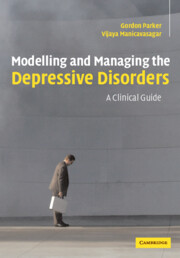Book contents
- Frontmatter
- Contents
- Acknowledgements
- Introduction
- Part I The current model for depressive disorders and its impact on clinical management
- Part II The diagnosis and management of melancholic and psychotic depression
- Part III An introduction to non-melancholic depression
- 7 Our model of non-melancholic depression
- 8 Self-esteem
- 9 Personality style and functioning
- 10 Identifying the constructs to non-melancholic depression: stress
- 11 Resilience and vulnerability
- 12 Psychological interventions for non-melancholic depression
- Part IV Modelling and managing the non-melancholic depressive disorders
- Appendix 1 The DMI-18 and the DMI-10
- Appendix 2 The CORE system of measuring psychomotor disturbance
- Appendix 3 The temperament and personality measure
- References
- Index
11 - Resilience and vulnerability
from Part III - An introduction to non-melancholic depression
Published online by Cambridge University Press: 17 August 2009
- Frontmatter
- Contents
- Acknowledgements
- Introduction
- Part I The current model for depressive disorders and its impact on clinical management
- Part II The diagnosis and management of melancholic and psychotic depression
- Part III An introduction to non-melancholic depression
- 7 Our model of non-melancholic depression
- 8 Self-esteem
- 9 Personality style and functioning
- 10 Identifying the constructs to non-melancholic depression: stress
- 11 Resilience and vulnerability
- 12 Psychological interventions for non-melancholic depression
- Part IV Modelling and managing the non-melancholic depressive disorders
- Appendix 1 The DMI-18 and the DMI-10
- Appendix 2 The CORE system of measuring psychomotor disturbance
- Appendix 3 The temperament and personality measure
- References
- Index
Summary
In Chapters 8–10, we defined three components to the development of a non-melancholic disorder. Our emphasis in these chapters was on disorder risk, vulnerability, and their contribution to disorder onset. This is helpful to understand how an individual may become depressed and how treatment might assist. It is also important to consider the opposing pole of resilience, for strategies need to be applied to assist people to stay well and not experience repeated episodes. Thus, we now consider ‘Resilience’.
In her book entitled ‘Resilience’, Deveson (2003) observes that, although the concept is difficult to define, we all seem to know it and we can usually identify those whom we would call ‘resilient’. In the Oxford English Dictionary, resiliency is referred to as the ability to rebound or resume shape after stretching, not dissimilar to Hooke's Law. When used in the context of psychological well-being, resiliency usually refers to the recuperative power of an individual in coping with extreme or unusual stressors, such as a serious financial loss or the breakup of an important relationship. Definitions of resilience and resiliency have also changed over time to reflect some of the key virtues of a given society at a certain time. For example, 300 years ago, the ability of black slaves in America to tolerate and survive their numerous hardships would not have been regarded as particularly noteworthy.
Information
- Type
- Chapter
- Information
- Modelling and Managing the Depressive DisordersA Clinical Guide, pp. 89 - 94Publisher: Cambridge University PressPrint publication year: 2005
